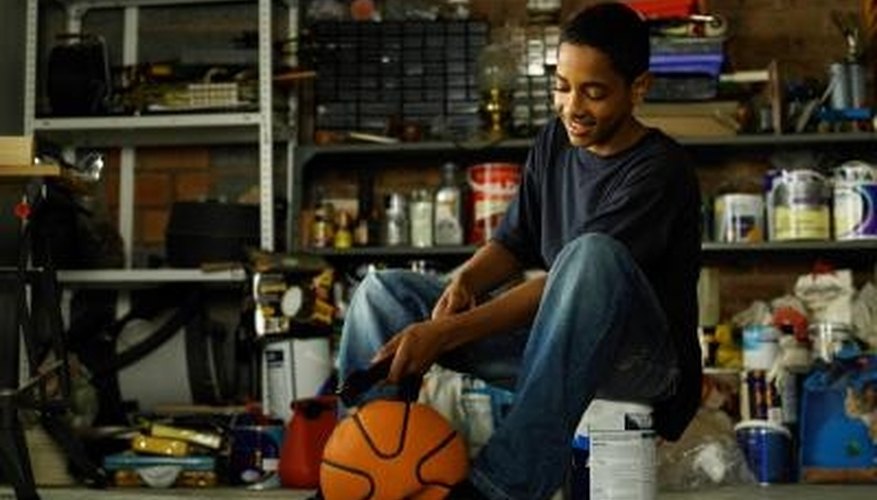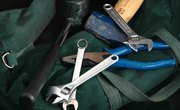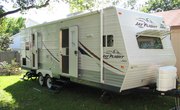
You want to get outside, or at least get the kids outside, so you grab a ball -- but it's flat! As you tirelessly pump air into the ball, you notice nothing is happening. Chances are your pump needs a little attention itself. Troubleshooting what is wrong with your pump and correctly installing the necessary parts will allow you to inflate your flat ball.
Items you will need
Ball
Floor pump
Hand pump
Pen
Tape
Paper
Floor Pump
Check the hose of the floor pump for cracks, discoloration or other possible defects. Most floor pumps have a self storage clip on the side of the steel or aluminum barrel -- the part of the floor pump that forces the air into your ball. Unclasp the hose and inspect it; if you see fine lines or clear cracks in the rubber hose, go online or to the place you originally purchased the pump and buy a replacement hose specific to your make and model.
Remove the old hose. Unscrew the hose from both the base and the head (the part that connects to the ball). Not all heads are removable; it depends upon the model. If the head is not removable, then the replacement hose will come with a new head. However, if the head unscrews, remove it. Now you should have a long, black rubber tube. If you find that neither one of these parts is removable, then you will have to buy a new pump.
Install the new hose. Reattach the head and screw the hose back into the base, and pump up your ball. If problems persist, you need check the head of the pump for damage or wear.
Unscrew the head of the pump from the hose. The head may come off as one piece, or it may have several sections that can be unscrewed or pulled apart. If the head is attached to the hose, unscrew the end of the head that normally holds the needle. Carefully remove each part and use tape to label the assembly order, or draw it out on paper. Make sure to note the direction the part came out in; this way, you can put it back together correctly.
Inspect the inside parts for wear. The inside components of the pump's head differ among models, but most consist of at least three parts: an O-ring, a head cap and a valve stem. More advanced floor pump models may have a piston, O-ring, head cap, plunger, and a valve stem gasket. If you notice a crack or wear on any of the pieces, return to where you purchased the pump or order the replacement kit online. Most pumps offer kits and not individual pieces, unless it is a high-quality pump. Then, reverse the order in which you removed the parts and pump up your ball.
Hand Pump
Inspect the barrel or the rubber pump of the tool. If the hand pump has a metal barrel, check for dents, holes or cracks. If it has a rubber pump, inspect it for punctures, cracks and deterioration due to time or exposure to the elements. In either case, if damage is noted, try to take the pump apart. If you can disassemble it, write down the order in which you removed the pieces. Then order the replacement part. If the parts are not removable, you will have to buy a new pump.
Remove the head from the barrel or rubber pump. Similar to floor pumps, some hand held pumps' heads unscrew. Remember to write down or use tape to label the order in which you remove the parts for easy reassembly. Check these parts for wear. If parts are cracked or worn, buy a replacement kit. Not all hand pumps have removable parts; if yours does not come apart, you will have to buy a new one.
Install the new parts. Replace the damaged part of the pump with the kit, barrel or rubber pump. Make sure to follow the order you wrote down or labeled the old parts with to assure you reassemble the pump correctly. Then insert the needle into the head and pump up the ball.
Warnings
- The parts inside the head of the pump are very small and need to go back in the exact order in which they came out. Make sure your sketch is clear; pay attention to not only the order but the direction the part originally faced when putting it back together.
Tips
- To make sure you get the right parts, take your pump with you when you shop for replacement parts.
References
Tips
- To make sure you get the right parts, take your pump with you when you shop for replacement parts.
Warnings
- The parts inside the head of the pump are very small and need to go back in the exact order in which they came out. Make sure your sketch is clear; pay attention to not only the order but the direction the part originally faced when putting it back together.
Writer Bio
Jessica Ginster began writing in 1999, with clients ranging from the National Museum of Natural Science in Taiwan to Kiko's Enterprises Corp. in New Jersey. She has also served as a contributing writer for "Nucleic Acids Research" and other publications. Ginster graduated with a B.A./B.S. in biology and philosophy from Alverno College in Milwaukee, Wis.



